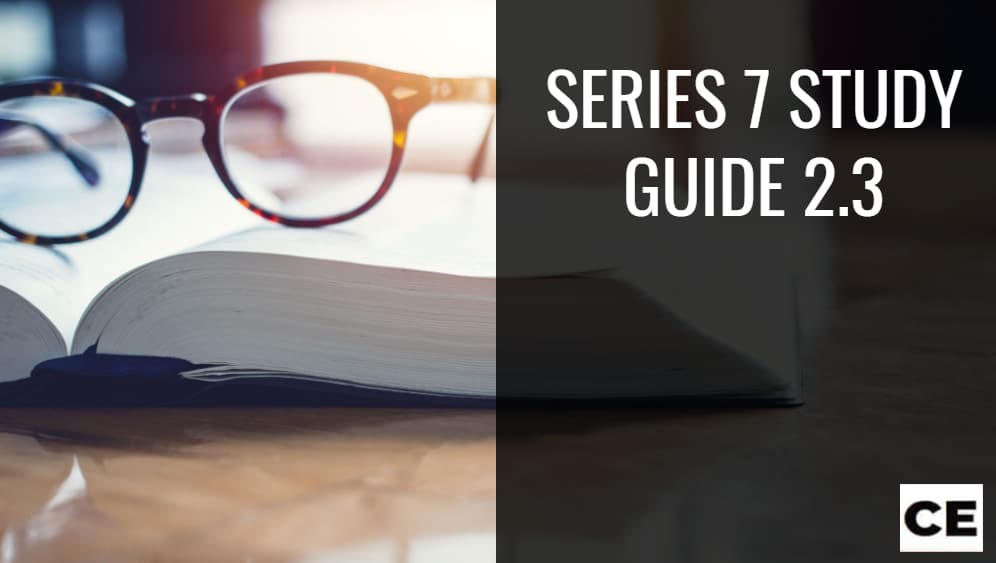Series 7 Study Guide Navigation
- Series 7 Study Guide Home
- 1.1 Contact with potential and current customers, marketing material development, approval, and distribution
- 1.2 Describing investment products to potential and current customers
- 2.1 Tells potential customers about the account types available and discloses their restrictions
- 2.2 Secures and updates information about customers along with relevant information and documents
- 2.3 Gather customer investment profile information
- 2.4 Get necessary supervisory approval to open accounts and make account changes
- 3.1 Passing on all investment strategy information to customers
- 3.2 Analyze customer’s portfolio of investments as well as product options to determine suitability
- 3.3 Disclose to clients characteristics and risks of investment products
- 3.4 Communications with customers
- 4.1 Providing current quotes for investors
- 4.2 Processing and confirming customers’ transactions as per regulations
- 4.3 Notifies the correct supervisor, helps with solving discrepancies, disputes, errors, and all complaints
- 4.4 Dealing with margin issues
No matter what, even the most thorough registered representative is going to receive a customer complaint against them at some point.
That’s just par for the course.
In this section, we take a look at how these complaints need to be dealt with according to FINRA regulations.
Handling customer complaints and reporting disciplinary incidents
There are various reporting requirements as specified by FORM U4.
Form U4
When a representative registers as an associated person of a FINRA member firm, they will need to file a Form U4.
There’s lots of information that’s covered by this form including:
- Name (or aliases used)
- Address
- Residency history over the last five years
- The employment history of the last 10 years (with the last three years verified
- Any arrest or convictions
Should there have been any arrests to report, full disclosure must be provided on the disclosure reporting page (DRPs).
A member firm will have all of the qualifications investigated for all newly appointed registered representatives.
This includes their education, qualifications, and experience as well as their reputation and character.
It’s a thorough check of whether the credentials of a candidate are in order or not.
Individuals may be barred should they provide misleading information on any part of the Form U4 but particularly when it comes to:
- Their personal history
- Their disciplinary record
- Their encounters with law enforcement agencies
Note that the principal could be liable as well if they signed the Form U4 without prior due diligence
We spoke earlier about DRPs, and they are a massive part of Form U4 for some and amount to nothing for others.
There are six categories of disclosure on the DRP.
These are:
- Criminal disclosure: For felonies and financially related misdemeanors
- Regulatory action disclosure: SRO, SEC, and/or state regulators
- Civil judicial disclosure: Any civil cases that are not related to securities
- Customer complaint disclosure/Civil litigation disclosure/Arbitration
- Termination disclosure
- Financial disclosure: Including unsatisfied judgments and liens, surety bond payments, and bankruptcy
Procedures for customer complaints
For customer complaints, each member firm is going to have its own procedures in place.
Having said that, there are some elements that will be common in all of these.
Let’s start by first seeing what FINRA says a customer complaint is:
“For purposes of this Rule, “customer complaint” means any grievance by a customer or any person authorized to act on behalf of the customer involving the activities of the member or a person associated with the member in connection with the solicitation or execution of any transaction or the disposition of securities or funds of that customer.”
As for how complaints should be recorded, FINRA describes that too.
” Each member shall keep and preserve in each office of supervisory jurisdiction either a separate file of all written customer complaints that relate to that office (including complaints that relate to activities supervised from that office) and action taken by the member, if any, or a separate record of such complaints and a clear reference to the files in that office containing the correspondence connected with such complaints. Rather than keep and preserve the customer complaint records required under this Rule at the office of supervisory jurisdiction, the member may choose to make them promptly available at that office, upon request of FINRA. Customer complaint records shall be preserved for a period of at least four years.”
Let’s break that down.
Basically, all customer complaints, if written, must be kept by member firms for a period of four years.
A record must also be kept of the member firm’s actions in dealing with those customer complaints.
If a complaint is not made in writing, FINRA doesn’t see it as a complaint at all.
When a complaint is received, what’s the process that member firms should then follow?
Should a customer send a written complaint to a registered representative, the first thing that must happen is that the person designated by the written procedures manual regarding complaints must be informed.
For the most part, that’s usually the branch manager, but it could even be a member of the legal department of the firm.
When a complaint is about a registered representative, it should be discussed with them first before the customer is contacted.
The idea should always be that before it needs to go through formal procedures as outlined by FINRA, a solution, if possible, should be found first.
Either arbitration or mediation will follow should an amicable solution not be found.
Rules and methods pertaining to FINRA’s complaint resolution
So what are the methods used by FINRA when it comes to complaint resolution?
Code of Arbitration procedure
Instead of going to court to sort out a dispute, an effective alternative is an arbitration.
This is a private process in which the two particles try to reach an amicable agreement.
This is done through one or several individuals hearing the various arguments, reviewing evidence, and then coming to a decision regarding the dispute.
FINRA has a Code of Arbitration procedure which is mandatory in situations when:
- A member brings a complaint against either another member or a clearing agency or vice versa
- A member brings a complaint against an associated person or vice versa
- An associated person brings a complaint against another associated person or vice versa
When it comes to customer complaints, there are two codes related to mandatory arbitration: the Industry Code and the Customer Code.
Almost all accounts opened for new customers will include a pre-dispute arbitration clause.
This will be signed by customers when filling in their new account forms.
If this is the case and a customer has signed this clause, any complaints that they may have will always be arbitrated via the Code of Arbitration.
Note that if there is no arbitration agreement signed by a customer, the customer still has the right to ask for an arbitration case in a dispute with a member.
The reverse isn’t true, however.
Note that something that’s not subject to arbitration is a class action claim.
Unless parties agree to it, arbitration is not required for the following:
- When an employee of a member firm brings a claim of employment discrimination
- When an employee of the member firm brings a claim of sexual harassment
There are numerous advantages to arbitration when compared to a court case.
- Arbitration is less time consuming than a court case
- Arbitration saves money (legal fees can get very expensive)
- Arbitration decisions are final and no appeals are allowed
Although one party will lose out in arbitration, there is no doubt that it’s a brilliant way to help settle disputes.
The Series 7 exam may include a question about the pre-dispute arbitration agreement.
Note that a member firm has 10 business days to send a customer a copy of this document should they request to see it.
Now that we know the background to arbitration, how does the initiation of proceedings work?
When a dispute is unresolved, a claim to initiate arbitration proceedings can be filed with FINRA.
This will have to be addressed to the director of arbitration.
Of course, the main part of what needs to be sent includes a claim that will describe:
- What the dispute is about
- Provide any necessary support documentation
- The remedy (for example, the party bringing the dispute might want to be paid a specific dollar amount)
The filing fee will also need to be paid at this point, so the documentation should include a check for the necessary amount.
Once all the documentation has been received by the director of arbitration, the other party involved in the dispute is sent all the details of the claim.
It’s now up to them to respond.
They will need to do that within 45 calendar days and not only to the director but the claimant as well.
That response needs to include any defense they have to the allegations made by the claimant.
It can also include counterclaims should there be any.
At the sole discretion of the director, should a respondent not present their answers within the 45-day period, they may be stopped from stating their case (including arguments against or their defense) at the arbitration.
An interim or permanent injunction can be asked for should an irreparable injury to one of the parties have taken place.
That party must be able to show that unless immediate relief is afforded to them, they will suffer permanent harm.
They must also be able to show that based on the merits thereof, their case is likely to be a success.
Mediation
Let’s move on to mediation.
This is another way to resolve disputes and the main advantage of this is that it doesn’t cost much.
Mediation has to be agreed to by both parties and will take place before the hearing opens.
The idea here is to work out a settlement at this meeting that is amicable to both parties.
This whole process is carried out with a mediator guiding it and helping the parties come to a solution on their own accord.
A hearing will still be held should mediation not be successful.
If a person has served as the mediator before the hearing takes place, they cannot form part of the arbitration panel as well.
From time to time, mediation might solve some aspects of the dispute but not all of it.
Those areas of the dispute that are still in contention will then form the basis of the hearing.
When a memorandum of understanding is signed by both of the parties involved in the dispute, it is said to have been settled.
During the mediation process, if one of the parties involved in the dispute feels the need to withdraw, they may do so.
They do not need the consent of either the other party or the mediator for that matter.
Selection of arbitrators
The next thing to cover is how arbitrators are selected.
Arbitrators are divided into two groups: nonpublic and public.
A list of both of these groups is kept by FINRA.
Let’s look into both of these groups in a little more detail.
First, we have nonpublic arbitrators:
These are people who have worked in the financial industry.
They can include:
- Those that have had a connection to mutual funds
- Those that have had a connection to hedge funds
- Those that have had a connection to an investment adviser
Non public arbitrators also include financial industry professionals who either provide a service to or represent parties of investors that have been involved in disputes.
These disputes can include transactions or investment accounts.
These can include:
- Attorneys
- Accountants
- Other professionals linked to the financial industry
Note that this group can become public arbitrators if they serve a five-year cooling-off period (if the affiliation is based on their own activities is ended) and or two years (if the affiliation is based on another party’s activities).
As for public arbitrations, if someone doesn’t meet the definition of a nonpublic arbitrator as we’ve set out above, they may act as a public arbitrator.
Arbitration thresholds and simplified arbitration
There are rules that guide arbitration thresholds and this is based on dollar amounts:
- Should it be $50,000 or less then only one arbitrator is needed
- Should it be between $50,000 and $100,000 then usually one arbitrator is needed but parties can agree to appoint three instead
- Should it be between $100,000 and any number above this then three arbitrators are necessary unless both parties agree that one should be appointed.
When arbitration cases are anything lower than $50,000 a simplified arbitration process is possible.
So how does that work?
Well, in a simple arbitration, a single arbitration looks at all the evidence and then within 30 days will return with a binding decision.
It’s the most cost worthy way of dealing with disputes.
When a member of the public is one of the parties involved in arbitration, a public arbitrator will hear the case if only one is needed based on the dollar amounts we’ve already discussed.
A majority of the arbitrators will be public should three be needed while the panel can consist of three public arbitrators if this is requested.
Panel members can be nonpublic when a member of the public is not involved and the case is between two member firms, for example, and a statutory discrimination claim does not form the basis thereof.
When an associated person is involved, however, the panel can include public arbitrators as well.
Once the case has been decided, how do the monetary awards work?
Well, there’s a time frame within which the monetary awards have to be paid to the winning party and that’s within 30 days of the decision having been made.
Should that not happen, interest will begin to accrue on the amount until such a time that it is paid.
Note that FINRA will make available all details of the arbitration claims, as well as the amount awarded in each separate case.
Lastly, a period of six years is the longest length of time that a claim can be eligible for submission to arbitration from the time that the event took place.
Complaint resolution rules and procedures
Now that we have covered arbitration, let’s look at the various rules and procedures that are linked to the resolution of complaints.
Code of Procedure (COP)
To start, we need to first chat about the COP.
This is something that FINRA will follow when it comes to violations related to trade practices.
For the Series 7 exam, it’s important that you remember the Code of Arbitration handles any disputes.
The COP, however, is specifically for violations.
In other words, someone has broken the law which could lead to severe penalties.
The difference between the two may well be tested.
FINRA manuals provided for customers
Many customers of member firms, especially those new to the investing game, don’t know the rights they have.
That’s why FINRA Rule 8110 is critical.
It states that should a customer make a request for a copy, the FINRA manual must be sent to them.
Many member firms nowadays make this manual available electronically for their customers.
Requirements for reporting as per FINRA Rule 4530
FINRA Rule 4530 has all the various requirements that are sent out when it comes to reporting potential violations.
FINRA requires that a report be filed with them no later than 30 calendar days after the event has taken place.
At that point, the member firm will know one of its members or a person associated with the firm:
- Has broken federal securities laws
- Are the subject of a customer complaint regarding either forgery, theft, or the embezzlement of assets
- Has either been expelled or suspended by another self-regulating agency
- Has been indicted, convicted, or plead either no contest or guilty to a criminal offense
- Is a respondent or defendant in any case related to securities or commodities in excess of $15,000
- Is up for statutory disqualification
- Is currently part of in-house disciplinary action that involves termination, suspension, holding of commissions, or fines over $2,500
What sanctions are brought against either a member or associated person that has violated various securities laws or rules?
Well, under FINRA Rule 8300, there are quite a few.
They include:
- Censure
- Fine
- Suspension for up to two years
- Expulsion
- Barring the member or associated person from dealing with other members
- Other sanctions as seen fit by FINRA
A member firm is not allowed to have one of their employees remain associated with them should that employee have been suspended.
This relates to clerical and administrative positions as well.
A suspended employee is not even allowed to be on the firm’s premises under FINRA regulations.
Not only that, but the suspensions also mean that the member firm cannot pay any form of remuneration to the suspended employee, including a salary, while the suspension is in force.
If they are owed money from before the suspension period, for example, outstanding commissions, that can be paid to them.
Having a suspended employee has a significant impact on the firm as well.
It means that in dealings with other members, the firm is treated as if it were a nonmember.
This means that it cannot take part in any member-to-member pricing or any form of underwriting as well.
What about appeals?
Well, when the decision is unacceptable for either of the sides, an appeal can be made.
This has to be placed with the National Adjudicatory Council.
And the time frame?
Well, once the decision is made, the member firm that would like to launch an appeal against it must do so in 25 days.
If they don’t, the decision as laid out initially will stand.
Should the party that is appealing the decision not agree with the NAC ruling following their appeal, they do have another course of action.
They can ask the SEC to take a look at the case.
Should their appeal still not pan out to their liking, the next step is federal court.
Note that the original decision will stand while all these appeals are ongoing, which can turn into a fairly lengthy process.
Clearing erroneous transactions
When terms of an interdealer trade show a clear error, Nasdaq is allowed to declare it null and void.
The power given to Nasdaq to carry this out is found under Rule 11892 and 11893.
The most obvious errors in this regard are those in price or the number of shares in the trade with Nasdaq either taking action of their own accord or responding to a complaint from one of the member firms involved in the trade.
In the case that a member wants a trade null and void, their request must be placed within half an hour of the trade having been executed.
Nasdaq will require that all the information around the trade be supplied to them and once they have that, they can come to one of three decisions:
- The trade will be voided
- The terms of the trade will be adjusted
- No action regarding the trade will be taken
Trades that fall under these rules are:
- Exchange-listed securities
- OTC equity securities
It’s critical to note that the latter of the two is the most likely to see no action taken by Nasdaq.
That’s because it’s other issues, problems in trading systems, and other events that often cause aberrant trading.
That said, each issue that is reported to Nasdaq will be treated with due diligence.









